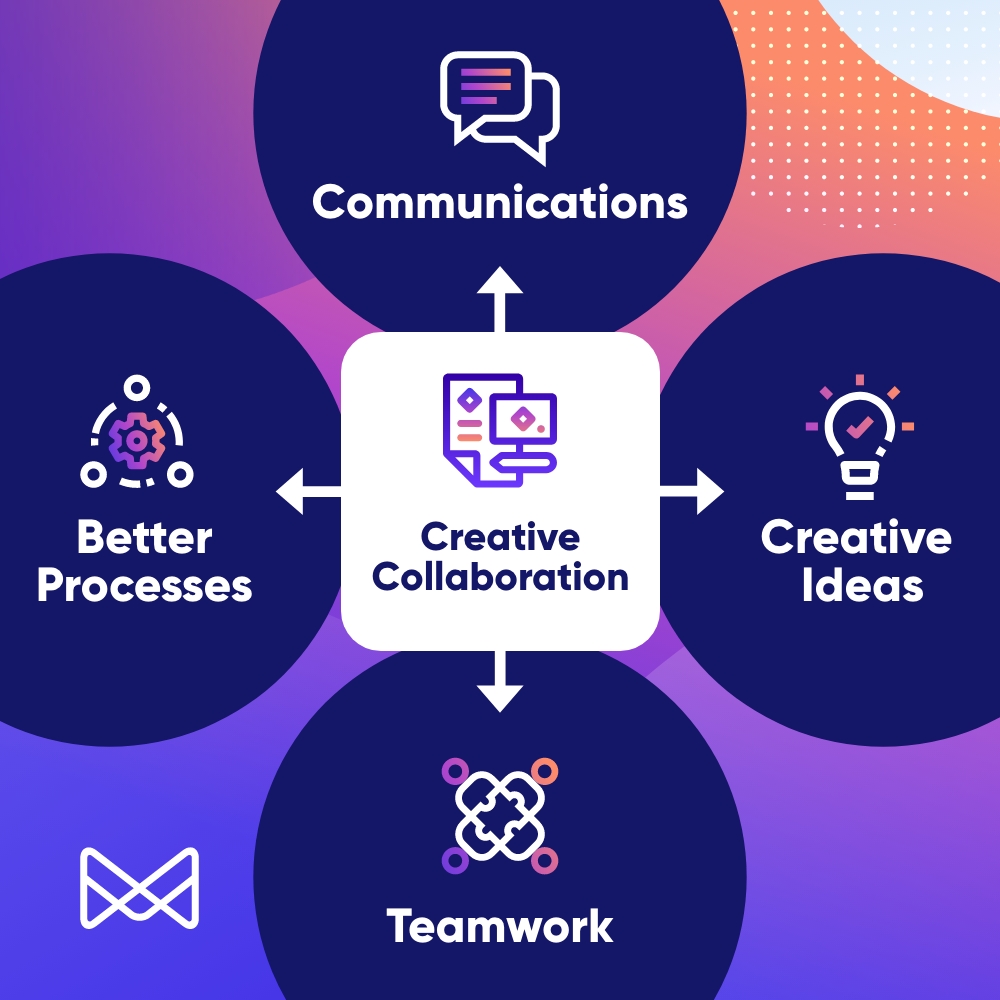Get news, updates, and insights delivered straight to your inbox.
Everything You Need for Successful Creative Collaboration

Effective marketing requires a clear strategy focused on specific goals. Businesses are better equipped to manage their campaigns by building internal and external relationships. Collaborating with others towards a common creative goal means overcoming challenges and improving efficiency.
Strategic marketing campaigns that are trying to stay competitive, improve internal marketing processes, or find ways to become more efficient will find success with creative collaboration.
Collaborative teams have a huge impact on organizational loyalty and morale. Marketing campaigns and growing businesses benefit from a better approval process for ads, banners, and other marketing assets.
If you’re looking for better marketing, creative collaboration is a key component. With the use of the right tools and platforms, creative collaboration enhances the capacity of teams to generate and execute new ideas. By connecting in more ways, individuals can work together to deliver greater performance at a lower cost.
A Typical Collaboration Process
The typical creative collaboration process involves having a discussion and hashing out ideas before establishing an agreed routine and communicating progress. Collaborators can then clarify specific areas of concern or reorganize the agenda according to everybody’s needs.
A stable foundation is necessary for collaborative efforts so that everybody is on the same page about the direction and goals of the project. Creative collaboration within teams creates communication and teamwork, leading to better processes and more creative ideas.

Marketing and brand resource management covers many types of digital asset sharing. Large banks, corporations, and other businesses win by expanding the creative process through collaboration. Target enterprises and multi-location or multi-channel companies have a lot to gain from using this type of online platform.
How Does Collaboration Expand the Creative Process?
Growth can lead to problems with asset organization when teams aren’t properly coordinated. This disorganization leads to things getting out of hand fast. Take for example how uncontrolled collaboration leads to disrupted workflows. Someone starts a project and requests marketing materials tagging multiple team members from different departments. Soon enough, you end up with inconsistent email threads that leaves everyone wondering if this project was worth it in the first place.
This means that collaboration needs to be controlled in order to yield the best results.
Collaboration makes the creative process more diverse, offering a wider variety of ideas and a unified organizational culture. Varied opinions lead to more innovations and improved productivity, allowing a goal-oriented workforce to participate in long-term strategic planning.
The flexibility to adapt to changing circumstances allows organizations to save resources, reduce waste and improve efficiency. For sales teams, this means finding their sales collateral fast and even customizing it as needed to maintain velocity.
So how does collaboration expand the creative process? Within collaborative environments, individuals become more invested in processes. Increased feedback during the developmental process lets organizations leverage each individual’s strengths to create a more supportive infrastructure.
What Tools and Platforms Do You Need to Have Successful Creative Collaboration?
Successful creative collaboration requires powerful tools. Collaborative platforms can be used to create, edit and share many different types of digital assets, including files, graphics, videos, and spreadsheets.
There are many available options for creative teams to ease their collaborative process.
Digital Asset Management
Companies can use online digital asset management (DAM) platforms to streamline their internal communications and improve sharing among employees and across departments.
Digital asset management tools such as Marcom Gather allow businesses to collaborate on creative projects remotely, giving them the flexibility to complete their projects while also saving them time and money.
Workflow
There are many workflow tools that give companies an edge when building and implementing their creative projects. Shared workflow tools allow collaborators to design, edit, and distribute their projects in real-time.
Collaborative software such as Bit.ai, nTask, and Automate.io offer organizations better ways to collaborate quickly and efficiently so they can focus on their creative projects.
Communications
Businesses looking for better ways to discuss and share ideas often turn to communications software for better creative collaboration. With software tools such as Slack, Trello, and Zoom, organizations are better equipped to succeed in their collaborative projects.
Businesses can leverage these communication platforms to share important messages and information across their organizations, improving productivity so teams can achieve their goals.
These resources are essential for collaborative teams to effectively build out more creative projects.
How Do Tools Improve Communication and Collaboration Across Teams and Departments?
Communication is essential in collaborative settings, especially in highly-regulated or compliance-driven environments where brand and message control is paramount. Organizations can improve collaboration with flexible distributed tools, organizations can improve collaboration, making it easier to work across teams and departments.
Creative collaboration tools allow users to connect from anywhere, giving them less overhead when they need to discuss important issues.
Remote tools offer a means for teams to create, edit, and distribute documents across various platforms. Shared cloud storage and integrated office suites ensure they can easily create and share ideas throughout the organization.
Online tools can be used for networking, conferencing, and meetups. They offer real-time group text and video chat. With VoIP and web calling, teams can communicate face to face in real-time. Teams leverage these tools to build initiatives around partnerships where a partner portal location is needed for the distribution of content.
How to Integrate Marketing Tools to Improve Creativity and Collaboration
Productive collaboration through the use of digital tools and solutions allows companies to make better investments. Distributed services across various platforms and services can be linked together to create a unified system for continuous communication.
The use of integrated marketing tools to enhance teams’ capabilities produces more original ideas and allows individuals to work together more effectively.
Marketing tools can be integrated with other advertising, sales, and public relations tools to create more specific user experiences. They can align goals and performance measures across departments with the organization’s strategic vision.
Let’s take for example how large enterprises need to create designs and collateral for campaigns that span through several cities and states. You have the central marketing team that needs to create the core message and vision of the campaign and align that with the geographical and partner-specific needs of every marketing channel being used. On top of that, you have stakeholders and other departments involved in proofing the campaign for legal, cost-related, and other reasons.
Given the complex nature of such a campaign, incorporating a marketing tool or platform that offers easy sharing and communication across campaign assets is the ideal solution to make things easier on everyone and allow the creativity of your team to reach its full potential.
These types of marketing tools come in different shapes and sizes these days and it’s hard to understand which marketing technology platform works best for different companies. Basically, you need to think about several questions when choosing any marketing solution for creative collaboration:
- Does the platform integrate with your other internal platform and tools?
- Does it offer fast and easy sharing and collaboration on marketing resources?
- Is it secure?
- Can you easily expand and control assets across different departments and partners?
- How easy is it to customize a single marketing asset to match specific geographic or partner channel needs?
The Future of Creative Collaboration at Work
Marketing management tools are being used more than ever before to help connect teams in a remote work environment. The future of creative collaboration at work will likely revolve around tighter integration of innovative tools and platforms in the digital space to ensure higher productivity and more efficiency.
With covid accelerating the growth of the marketing automation market, creative collaboration will only become faster and nimbler. While this may bring a smile to marketing managers’ faces, the sound of AI overtaking the industry also brings a bit of concern as to how much the so-called “creative” (right side) brain can keep up. Can humans create at a rate at which AI-controlled collaboration platforms can deliver? Nobody really knows, and that’s what makes this industry exciting.
Whatever the outcome, teams will need better support systems to keep up with growing demand and will continue to want a modern, efficient way to centralize and share digital assets.
Many organizations are starting to realize that creative collaboration allows teams to avoid frustrating problems like file scavenger hunts and lets them spend more time on the parts of their job that they actually enjoy.
The future of work means more decision-makers realizing that too much time is spent on busywork, like hunting for assets rather than focusing on growing the business. In the future, collaborative tools will continue to provide a robust solution to teams looking for ways to support their creative efforts.
You might also like


